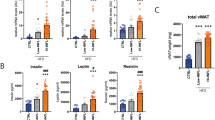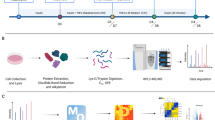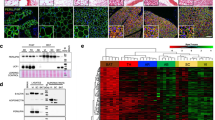Abstract
Objective:
Pigment epithelium-derived factor (PEDF) is a multifunctional protein with neurotrophic and anti-angiogenic properties. More recently it became evident that PEDF is upregulated in patients with type 2 diabetes and also contributes to insulin resistance in mice. During characterization of the secretome of in vitro differentiated human adipocytes by two-dimensional polyacrylamide gel electrophoresis and matrix-assisted laser desorption/ionization-MS, we found that PEDF is one of the most abundant proteins released by adipocytes. The aim of this study was to investigate the regulation and autocrine function of PEDF in human adipocytes and to determine its paracrine effects on human skeletal muscle cells (hSkMC) and human smooth muscle cells (hSMC).
Methods and results:
Human primary adipocytes secrete 130 ng ml−1 PEDF over 24 h from 1 million cells, which is extremely high as compared with adiponectin, interleukin-6 (IL-6) or IL-8. This release of PEDF is significantly higher than from other primary cells, such as adipose-tissue located macrophages (50-times), hSkMC and hSMC (5-times). PEDF protein expression significantly increases during adipogenesis, which is paralleled by increased PEDF secretion. Furthermore, tumor necrosis factor-α and hypoxia significantly downregulate PEDF protein levels. PEDF secretion was significantly reduced by troglitazone and hypoxia and significantly increased by insulin. Treatment of adipocytes and hSkMC with PEDF induced insulin resistance in adipocytes, skeletal and smooth muscle cells at the level of insulin-stimulated Akt phosphorylation, which was dose dependent and more prominent in adipocytes. Furthermore, inflammatory nuclear factor-κB (NF-κB) signaling was induced by PEDF. In hSMC, PEDF induced proliferation (1.7-fold) and acutely activated proliferative and inflammatory signaling pathways (NF-κB, p38 mitogen-activated protein kinase and mammalian target of rapamycin).
Conclusion:
PEDF is one of the most abundant adipokines and its secretion is inversely regulated by insulin and hypoxia. PEDF induces insulin resistance in adipocytes and hSkMC and leads to inflammatory signaling in hSMC. Because of these diverse actions, PEDF is a key adipokine, which could have an important role in diabetes and obesity-related disorders.
This is a preview of subscription content, access via your institution
Access options
Subscribe to this journal
Receive 12 print issues and online access
¥40,000 per year
only ¥3,333 per issue
Buy this article
- Purchase on SpringerLink
- Instant access to full article PDF
Prices may be subject to local taxes which are calculated during checkout







Similar content being viewed by others
References
Wellen KE, Hotamisligil GS . Inflammation, stress, and diabetes. J Clin Invest 2005; 115: 1111–1119.
Ahima RS . Adipose tissue as an endocrine organ. Obesity (Silver Spring) 2006; 14 (Suppl 5): 242S–249S.
Trayhurn P . Endocrine and signalling role of adipose tissue: new perspectives on fat. Acta Physiol Scand 2005; 184: 285–293.
Becerra SP . Structure-function studies on PEDF. A noninhibitory serpin with neurotrophic activity. Adv Exp Med Biol 1997; 425: 223–237.
Tombran-Tink J, Chader GG, Johnson LV . PEDF: a pigment epithelium-derived factor with potent neuronal differentiative activity. Exp Eye Res 1991; 53: 411–414.
Crowe S, Wu LE, Economou C, Turpin SM, Matzaris M, Hoehn KL et al. Pigment epithelium-derived factor contributes to insulin resistance in obesity. Cell Metab 2009; 10: 40–47.
Jenkins A, Zhang SX, Gosmanova A, Aston C, Dashti A, Baker MZ et al. Increased serum pigment epithelium derived factor levels in Type 2 diabetes patients. Diabetes Res Clin Pract 2008; 82: e5–e7.
Yamagishi S, Adachi H, Abe A, Yashiro T, Enomoto M, Furuki K et al. Elevated serum levels of pigment epithelium-derived factor in the metabolic syndrome. J Clin Endocrinol Metab 2006; 91: 2447–2450.
Filleur S, Nelius T, de Riese W, Kennedy RC . Characterization of PEDF: a multi-functional serpin family protein. J Cell Biochem 2009; 106: 769–775.
Jenkins AJ, Zhang SX, Rowley KG, Karschimkus CS, Nelson CL, Chung JS et al. Increased serum pigment epithelium-derived factor is associated with microvascular complications, vascular stiffness and inflammation in Type 1 diabetes. Diabet Med 2007; 24: 1345–1351.
Lamers D, Schlich R, Greulich S, Sasson S, Sell H, Eckel J . Oleic acid and adipokines synergize in inducing proliferation and inflammatory signaling in human vascular smooth muscle cells. J Cell Mol Med 2010, doi:10.1111/j.1582-4934.2010.01099.x.
Hauner H, Petruschke T, Russ M, Rohrig K, Eckel J . Effects of tumour necrosis factor alpha (TNF alpha) on glucose transport and lipid metabolism of newly-differentiated human fat cells in cell culture. Diabetologia 1995; 38: 764–771.
Dietze-Schroeder D, Sell H, Uhlig M, Koenen M, Eckel J . Autocrine action of adiponectin on human fat cells prevents the release of insulin resistance-inducing factors. Diabetes 2005; 54: 2003–2011.
Curat CA, Miranville A, Sengenes C, Diehl M, Tonus C, Busse R et al. From blood monocytes to adipose tissue-resident macrophages: induction of diapedesis by human mature adipocytes. Diabetes 2004; 53: 1285–1292.
Lehr S, Kotzka J, Avci H, Knebel B, Muller S, Hanisch FG et al. Effect of sterol regulatory element binding protein-1a on the mitochondrial protein pattern in human liver cells detected by 2D-DIGE. Biochemistry 2005; 44: 5117–5128.
Rabilloud T, Strub JM, Luche S, van Dorsselaer A, Lunardi J . A comparison between Sypro Ruby and ruthenium II tris (bathophenanthroline disulfonate) as fluorescent stains for protein detection in gels. Proteomics 2001; 1: 699–704.
Wichelhaus A, Russ M, Petersen S, Eckel J . G protein expression and adenylate cyclase regulation in ventricular cardiomyocytes from STZ-diabetic rats. Am J Physiol 1994; 267/2 (Part 2): H548–H555.
Hosogai N, Fukuhara A, Oshima K, Miyata Y, Tanaka S, Segawa K et al. Adipose tissue hypoxia in obesity and its impact on adipocytokine dysregulation. Diabetes 2007; 56: 901–911.
Rausch ME, Weisberg S, Vardhana P, Tortoriello DV . Obesity in C57BL/6J mice is characterized by adipose tissue hypoxia and cytotoxic T-cell infiltration. Int J Obes (London) 2008; 32: 451–463.
Ye J, Gao Z, Yin J, He Q . Hypoxia is a potential risk factor for chronic inflammation and adiponectin reduction in adipose tissue of ob/ob and dietary obese mice. Am J Physiol Endocrinol Metab 2007; 293: E1118–E1128.
Pasarica M, Sereda OR, Redman LM, Albarado DC, Hymel DT, Roan LE et al. Reduced adipose tissue oxygenation in human obesity: evidence for rarefaction, macrophage chemotaxis, and inflammation without an angiogenic response. Diabetes 2009; 58: 718–725.
Notari L, Baladron V, Aroca-Aguilar JD, Balko N, Heredia R, Meyer C et al. Identification of a lipase-linked cell membrane receptor for pigment epithelium-derived factor. J Biol Chem 2006; 281: 38022–38037.
Bernard A, Gao-Li J, Franco CA, Bouceba T, Huet A, Li Z . Laminin receptor involvement in the anti-angiogenic activity of pigment epithelium-derived factor. J Biol Chem 2009; 284: 10480–10490.
Chiellini C, Cochet O, Negroni L, Samson M, Poggi M, Ailhaud G et al. Characterization of human mesenchymal stem cell secretome at early steps of adipocyte and osteoblast differentiation. BMC Mol Biol 2008; 9: 26.
Kratchmarova I, Kalume DE, Blagoev B, Scherer PE, Podtelejnikov AV, Molina H et al. A proteomic approach for identification of secreted proteins during the differentiation of 3T3-L1 preadipocytes to adipocytes. Mol Cell Proteomics 2002; 1: 213–222.
Vankoningsloo S, De Pauw A, Houbion A, Tejerina S, Demazy C, De Longueville F et al. CREB activation induced by mitochondrial dysfunction triggers triglyceride accumulation in 3T3-L1 preadipocytes. J Cell Sci 2006; 119 (Part 7): 1266–1282.
Wang M, Wang JJ, Li J, Park K, Qian X, Ma JX et al. Pigment epithelium-derived factor suppresses adipogenesis via inhibition of the MAPK/ERK pathway in 3T3-L1 preadipocytes. Am J Physiol Endocrinol Metab 2009; 297: E1378–E1387.
Zvonic S, Lefevre M, Kilroy G, Floyd ZE, DeLany JP, Kheterpal I et al. Secretome of primary cultures of human adipose-derived stem cells: modulation of serpins by adipogenesis. Mol Cell Proteomics 2007; 6: 18–28.
Lange J, Yafai Y, Reichenbach A, Wiedemann P, Eichler W . Regulation of pigment epithelium-derived factor production and release by retinal glial (Muller) cells under hypoxia. Invest Ophthalmol Vis Sci 2008; 49: 5161–5167.
Rychli K, Kaun C, Hohensinner P, Dorfner A, Pfaffenberger S, Niessner A et al. The antiangiogenic factor PEDF is present in the human heart and is regulated by anoxia in cardiac myocytes and fibroblasts. J Cell Mol Med 2010; 14: 198–205.
Notari L, Miller A, Martinez A, Amaral J, Ju M, Robinson G et al. Pigment epithelium-derived factor is a substrate for matrix metalloproteinase type 2 and type 9: implications for downregulation in hypoxia. Invest Ophthalmol Vis Sci 2005; 46: 2736–2747.
Yamagishi S, Inagaki Y, Nakamura K, Abe R, Shimizu T, Yoshimura A et al. Pigment epithelium-derived factor inhibits TNF-alpha-induced interleukin-6 expression in endothelial cells by suppressing NADPH oxidase-mediated reactive oxygen species generation. J Mol Cell Cardiol 2004; 37: 497–506.
Matsui T, Yamagishi S, Nakamura K, Kikuchi S, Inoue H . Azelnidipine, a dihydropyridine-based calcium antagonist, inhibits angiotensin II-induced oxidative stress generation and downregulation of pigment epithelium-derived factor mRNA levels in microvascular endothelial cells. Drugs Exp Clin Res 2005; 31: 215–219.
Trayhurn P . Endocrine and signalling role of adipose tissue: new perspectives on fat. Acta Physiol Scand 2005; 184: 285–293.
Wang B, Wood IS, Trayhurn P . Dysregulation of the expression and secretion of inflammation-related adipokines by hypoxia in human adipocytes. Pflugers Arch 2007; 455: 479–492.
Gottschling-Zeller H, Rohrig K, Hauner H . Troglitazone reduces plasminogen activator inhibitor-1 expression and secretion in cultured human adipocytes. Diabetologia 2000; 43: 377–383.
Skurk T, Birgel M, Lee YM, Hauner H . Effect of troglitazone on tumor necrosis factor alpha and transforming growth factor beta expression and action in human adipocyte precursor cells in primary culture. Metabolism 2006; 55: 309–316.
Sell H, Laurencikiene J, Taube A, Eckardt K, Cramer A, Horrighs A et al. Chemerin is a novel adipocyte-derived factor inducing insulin resistance in primary human skeletal muscle cells. Diabetes 2009; 58: 2731–2740.
Chung C, Doll JA, Gattu AK, Shugrue C, Cornwell M, Fitchev P et al. Anti-angiogenic pigment epithelium-derived factor regulates hepatocyte triglyceride content through adipose triglyceride lipase (ATGL). J Hepatol 2008; 48: 471–478.
Nelson J, McFerran NV, Pivato G, Chambers E, Doherty C, Steele D et al. The 67 kDa laminin receptor: structure, function and role in disease. Biosci Rep 2008; 28: 33–48.
Zamiri P, Masli S, Streilein JW, Taylor AW . Pigment epithelial growth factor suppresses inflammation by modulating macrophage activation. Invest Ophthalmol Vis Sci 2006; 47: 3912–3918.
Ho TC, Yang YC, Chen SL, Kuo PC, Sytwu HK, Cheng HC et al. Pigment epithelium-derived factor induces THP-1 macrophage apoptosis and necrosis by the induction of the peroxisome proliferator-activated receptor gamma. Mol Immunol 2008; 45: 898–909.
Yamagishi S, Matsui T, Nakamura K, Imaizumi T . Pigment epithelium-derived factor (PEDF) inhibits angiotensin II-induced smooth muscle cell proliferation through its anti-oxidative properties. Protein Pept Lett 2007; 14: 615–617.
Sell H, Eckardt K, Taube A, Tews D, Gurgui M, Echten-Deckert G et al. Skeletal muscle insulin resistance induced by adipocyte-conditioned medium: underlying mechanisms and reversibility. Am J Physiol Endocrinol Metab 2008; 294: E1070–E1077.
Nakamura K, Yamagishi S, Matsui T, Yoshida T, Takenaka K, Jinnouchi Y et al. Pigment epithelium-derived factor inhibits neointimal hyperplasia after vascular injury by blocking NADPH oxidase-mediated reactive oxygen species generation. Am J Pathol 2007; 170: 2159–2170.
Rychli K, Huber K, Wojta J . Pigment epithelium-derived factor (PEDF) as a therapeutic target in cardiovascular disease. Expert Opin Ther Targets 2009; 13: 1295–1302.
Fernandez-Garcia NI, Volpert OV, Jimenez B . Pigment epithelium-derived factor as a multifunctional antitumor factor. J Mol Med 2007; 85: 15–22.
Chung C, Doll JA, Stellmach VM, Gonzales J, Surapureddi S, Cornwell M et al. Pigment epithelium-derived factor is an angiogenesis and lipid regulator that activates peroxisome proliferator-activated receptor alpha. Adv Exp Med Biol 2008; 617: 591–597.
Acknowledgements
This work was supported by the Ministerium für Wissenschaft und Forschung des Landes Nordrhein-Westfalen, the Bundesministerium für Gesundheit, the Deutsche Forschungsgemeinschaft (SE 1922/2-1), the Commission of the European Communities (Collaborative Project ADAPT, contract number HEALTH-F2-2008-201100), and EU COST Action BM0602. We thank Professor Liebau and her team, Department of Plastic Surgery, Florence-Nightingale-Hospital Düsseldorf, and PD Dr Andree and his team, Department of Plastic Surgery and Breast Reconstruction, Sana Hospital Düsseldorf-Gerresheim, for support in obtaining adipose tissue samples. The secretarial assistance of Birgit Hurow is gratefully acknowledged.
Author information
Authors and Affiliations
Corresponding author
Ethics declarations
Competing interests
The authors declare no conflict of interest.
Rights and permissions
About this article
Cite this article
Famulla, S., Lamers, D., Hartwig, S. et al. Pigment epithelium-derived factor (PEDF) is one of the most abundant proteins secreted by human adipocytes and induces insulin resistance and inflammatory signaling in muscle and fat cells. Int J Obes 35, 762–772 (2011). https://doi.org/10.1038/ijo.2010.212
Received:
Revised:
Accepted:
Published:
Issue Date:
DOI: https://doi.org/10.1038/ijo.2010.212



